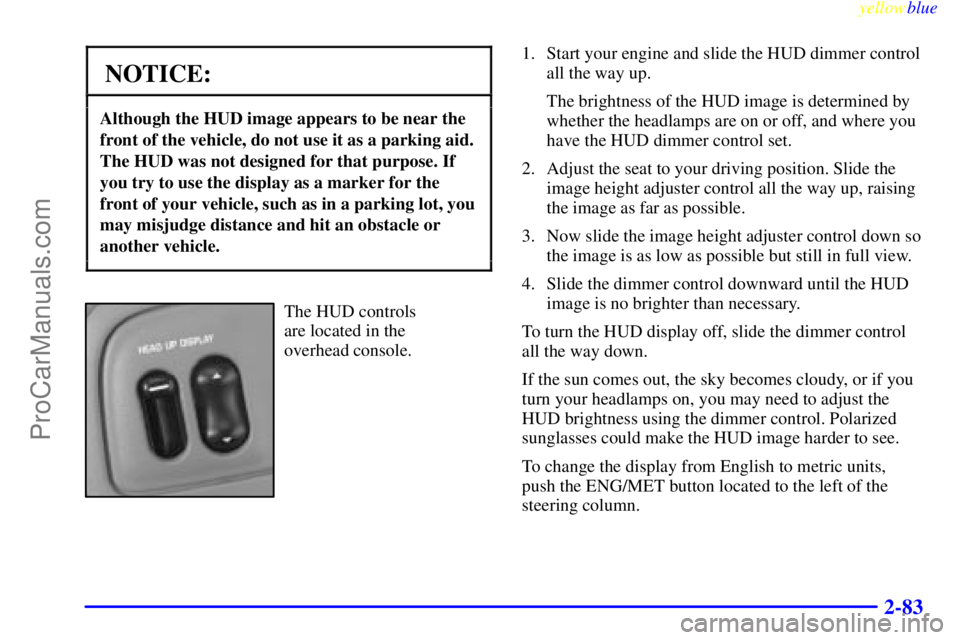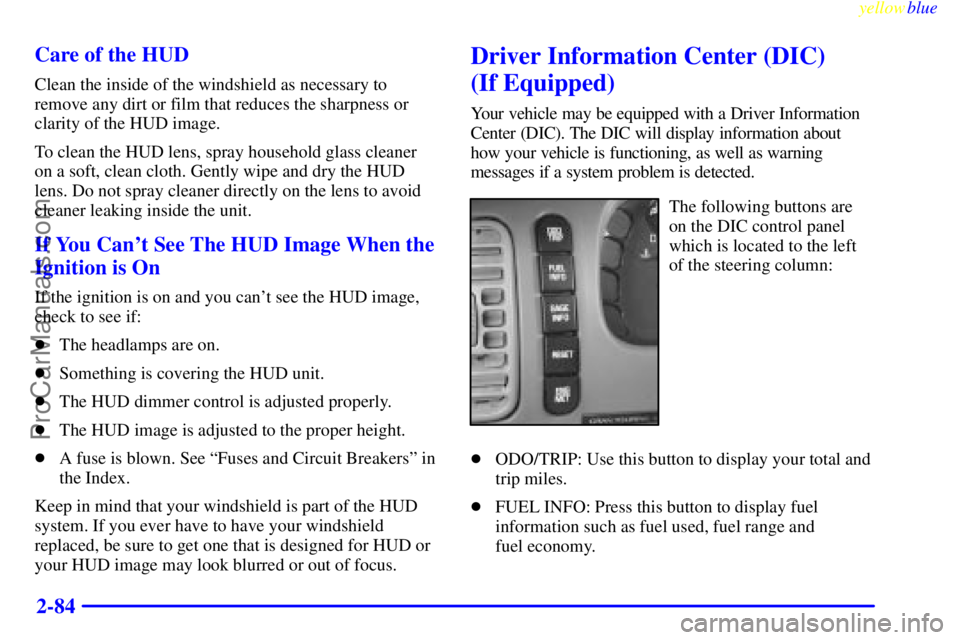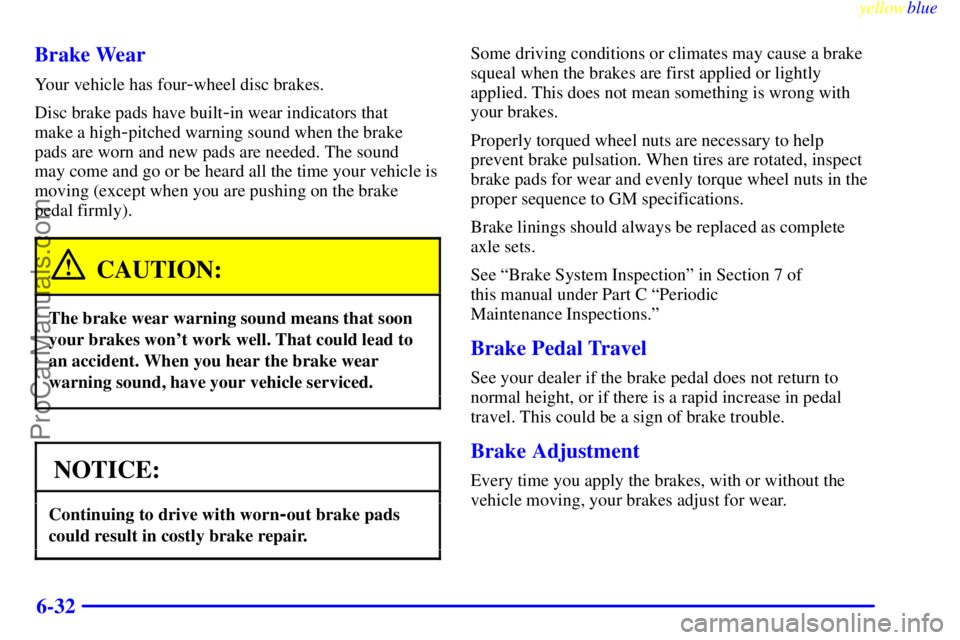Page 13 of 400

yellowblue
1-7 Head Restraints
Use this switch to move a front head restraint up or
down. Lift up on the switch to move the head restraint
up. Press down on the switch to move the head restraint
down. The top of the head restraint should be closest to
the top of your ears. This position helps reduce the
chance of a neck injury in a crash. When you move a
front seat head restraint up or down, the shoulder belt
height changes. On some models, the head restraints tilt
forward and rearward also.Some rear seats have adjustable head restraints. Slide an
adjustable head restraint up or down so that the top of
the restraint is closest to the top of your ears. This
position reduces the chance of a neck injury in a crash.
On some models, the rear seat head restraints tilt
forward and rearward also.
There are four different positions for the front seat head
restraints and three different positions for the rear seat
head restraints. Adjust either head restraint by grasping
the top of the restraint and moving it forward the way
you want it to go until you hear a click. It will then be
locked into that position until you need to move it again.
Pulling it forward past the last position will allow the
headrest to return to its full rear position.
ProCarManuals.com
Page 21 of 400
yellowblue
1-15
The lap part of the belt should be worn low and snug on
the hips, just touching the thighs. In a crash, this applies
force to the strong pelvic bones. And you'd be less likelyto slide under the lap belt. If you slid under it, the belt
would apply force at your abdomen. This could cause
serious or even fatal injuries. The shoulder belt should go
over the shoulder and across the chest. These parts of the
body are best able to take belt restraining forces.
The safety belt locks if there's a sudden stop or crash, or
if you pull the belt very quickly out of the retractor.
Shoulder Belt Height Adjuster
When you move a front seat head restraint, the shoulder
belt height changes. See ªHead Restraintsº in the Index.
ProCarManuals.com
Page 45 of 400
yellowblue
1-39
A forward-facing child restraint (C-E) positions a
child upright to face forward in the vehicle. These
forward
-facing restraints are designed to help protect
children who are from 20 to 40 lbs. (9 to 18 kg) and
about 26 to 40 inches (66 to 102 cm) in height, or up
to around four years of age. One type, a convertible
restraint, is designed to be used either as a rear
-facing
infant seat or a forward
-facing child seat.
ProCarManuals.com
Page 113 of 400
yellowblue
2-55 Garage Door Opener Compartment
The garage door opener storage area is located in the
headliner near the reading lamps. The following chart
and instructions will help you install your garage door
opener in the overhead storage area.
1. Push the extended tab (above the GARAGE button)
or insert a screwdriver between the tab and outer
edge of the cover. The garage door opener cover will
flip down.
2. Remove the square height adapters from the cover.
Refer to the chart to determine the number and
location of the height adapters for your garage door
opener. If your unit does not appear on the chart, you
will have to try different adapter number and
location combinations.
ProCarManuals.com
Page 116 of 400
yellowblue
2-58
3. Place the height adapters on the proper peg using the
suggested combinations or by lining up the height
adapters and the transmitter button on your garage
door opener.
4. Use the Velcro� found in the storage area and a
ttach the garage door opener securely inside the
console. Line up the transmitter button with the
height adapters.
5. Close the cover and test the GARAGE button.
If your garage door opener doesn't work after it is
installed, try another combination.
Front Storage Armrest
You may have a fold-down armrest between the front
seats that opens into a storage area. To open it, pull up
on the lever at the front edge. Inside are cupholders that
can be rotated forward for use with the armrest cover
closed. There is also a removable coinholder and a
storage area for cassette tapes and compact discs.
ProCarManuals.com
Page 141 of 400

yellowblue
2-83
NOTICE:
Although the HUD image appears to be near the
front of the vehicle, do not use it as a parking aid.
The HUD was not designed for that purpose. If
you try to use the display as a marker for the
front of your vehicle, such as in a parking lot, you
may misjudge distance and hit an obstacle or
another vehicle.
The HUD controls
are located in the
overhead console.1. Start your engine and slide the HUD dimmer control
all the way up.
The brightness of the HUD image is determined by
whether the headlamps are on or off, and where you
have the HUD dimmer control set.
2. Adjust the seat to your driving position. Slide the
image height adjuster control all the way up, raising
the image as far as possible.
3. Now slide the image height adjuster control down so
the image is as low as possible but still in full view.
4. Slide the dimmer control downward until the HUD
image is no brighter than necessary.
To turn the HUD display off, slide the dimmer control
all the way down.
If the sun comes out, the sky becomes cloudy, or if you
turn your headlamps on, you may need to adjust the
HUD brightness using the dimmer control. Polarized
sunglasses could make the HUD image harder to see.
To change the display from English to metric units,
push the ENG/MET button located to the left of the
steering column.
ProCarManuals.com
Page 142 of 400

yellowblue
2-84 Care of the HUD
Clean the inside of the windshield as necessary to
remove any dirt or film that reduces the sharpness or
clarity of the HUD image.
To clean the HUD lens, spray household glass cleaner
on a soft, clean cloth. Gently wipe and dry the HUD
lens. Do not spray cleaner directly on the lens to avoid
cleaner leaking inside the unit.
If You Can't See The HUD Image When the
Ignition is On
If the ignition is on and you can't see the HUD image,
check to see if:
�The headlamps are on.
�Something is covering the HUD unit.
�The HUD dimmer control is adjusted properly.
�The HUD image is adjusted to the proper height.
�A fuse is blown. See ªFuses and Circuit Breakersº in
the Index.
Keep in mind that your windshield is part of the HUD
system. If you ever have to have your windshield
replaced, be sure to get one that is designed for HUD or
your HUD image may look blurred or out of focus.
Driver Information Center (DIC)
(If Equipped)
Your vehicle may be equipped with a Driver Information
Center (DIC). The DIC will display information about
how your vehicle is functioning, as well as warning
messages if a system problem is detected.
The following buttons are
on the DIC control panel
which is located to the left
of the steering column:
�ODO/TRIP: Use this button to display your total and
trip miles.
�FUEL INFO: Press this button to display fuel
information such as fuel used, fuel range and
fuel economy.
ProCarManuals.com
Page 290 of 400

yellowblue
6-32 Brake Wear
Your vehicle has four-wheel disc brakes.
Disc brake pads have built
-in wear indicators that
make a high
-pitched warning sound when the brake
pads are worn and new pads are needed. The sound
may come and go or be heard all the time your vehicle is
moving (except when you are pushing on the brake
pedal firmly).
CAUTION:
The brake wear warning sound means that soon
your brakes won't work well. That could lead to
an accident. When you hear the brake wear
warning sound, have your vehicle serviced.
NOTICE:
Continuing to drive with worn-out brake pads
could result in costly brake repair.
Some driving conditions or climates may cause a brake
squeal when the brakes are first applied or lightly
applied. This does not mean something is wrong with
your brakes.
Properly torqued wheel nuts are necessary to help
prevent brake pulsation. When tires are rotated, inspect
brake pads for wear and evenly torque wheel nuts in the
proper sequence to GM specifications.
Brake linings should always be replaced as complete
axle sets.
See ªBrake System Inspectionº in Section 7 of
this manual under Part C ªPeriodic
Maintenance Inspections.º
Brake Pedal Travel
See your dealer if the brake pedal does not return to
normal height, or if there is a rapid increase in pedal
travel. This could be a sign of brake trouble.
Brake Adjustment
Every time you apply the brakes, with or without the
vehicle moving, your brakes adjust for wear.
ProCarManuals.com